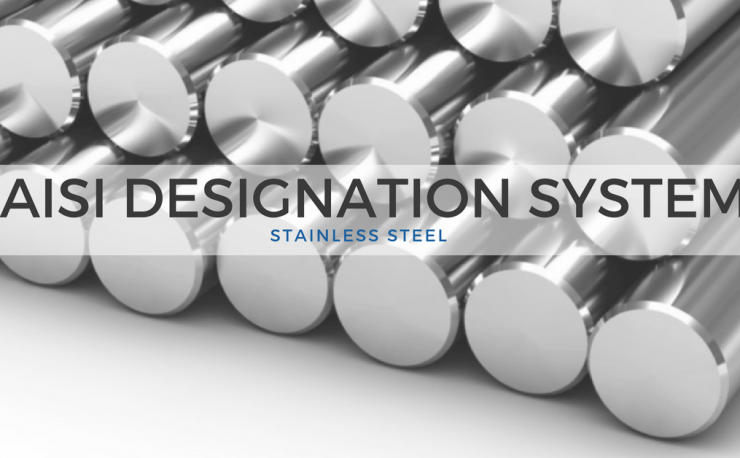
AISI standards is one of the most popular methods of designation in the field of stainless steel (American Iron and Steel Institute). The latter is is an association of North American steel producers. In our today’s post we want to learn more about this designation system that allows the identification of types of steel.
AISI standards. All the different acronyms.
This type of designation identifies the different types of steel. But how do it? Through a three-digit acronym, with a possible additional letter. The class of resistance is determined by the first digit. Here some example:
- AISI-2XX – austenitic chromium-nickel- manganese steels
- AISI-3XX – austenitic chromium-nickel steels
- AISI-4XX – ferritic or martensitic chromium steels
- AISI-5XX – martensitic medium chrome steels
- AISI-6XX – chromium precipation hardening steels.
Specifically, the second pair of digits is required to distinguish one type of material from another. The letters, however, shows another type of information such as
- L = low percentage of carbon (brings good weldability)
- Ti = presence of titanium (ensures a complete corrosion resistance in welds of thick elements)
- F = presence of sulphur (it helps the machinability)
- N = presence of nitrogen dissolved in alloy (to provide greater pitting resistance and external contamination).
Steel series.
According to the AISI classification, steels can be divided into different series.
- Carbon steel (1000 series): four-digit number + any prefix
- First digit: 1
- Second digit: 0 (carbon steel), 1 (resulphurized carbon steels, 2 (resulphurized and rephosphorized carbon steels)
- Third and fourth digits: carbon content *100.
- Low alloy steel: four-digit number
- First and second digits: identify the series
- Two last digits: identify the carbon content *100.
- High-alloy steel
- 200 series (austenitic chromium- manganese steels)
- 300 series (austenitic chromium-nickel steels)
- 400 series (ferritic or martensitic steels).
Stainless steel and the AISI nomenclatures.
As you know, there are several types of steels, all almost always known under the AISI steel notation. The latter is often perceived (incorrectly) as “synonymous” with “stainless steel”. Stainless steels, then, distinguished by the weight % of constituent alloy elements. What are the most common ones?
- 304 – Cr (18%) Ni (10%) C (0,05%)
- 304 L – (Low Carbon): Cr (18%) Ni (10%) C (< 0.03%)
- 316 – Cr (16%) Ni (11.3/13 %) Mo (2/3 %)
- 316 L – (Low Carbon): Cr (16,5/18,5%) Ni (10,5/13,5%) Mo (2/2,25%) C (< 0.03%)
- 316 LN – (Low Carbon Nitrogen) (presence of dissolved nitrogen in the crystal lattice of the material)
- 316 LN ESR (electro-slag remelting)
- 430: Cr (16/18 %) C (0,08%).
Looking for AISI 304 and 316 stainless steel fasteners, fittings, marine hardware and fasteners for photovoltaic systems? Please visit our website. Sign up to our e-commerce to view real-time prices and availabilities of all our products.
Click hereDo you want to read other posts? Continues here.





Dear Sirs,
Please send me information about steels to be treated by plasma nitriding. Designation and composition if possible.
Thank you very much
Hi Amado,
To answer your question I would like to propose this publication of the polytechnic of Milan: http://www.fa-fe.com/files/pdf/libri_articoli/it/9-Gli_acciai_da_nitrurazione.pdf
In the text you can find the different types of nitriding treatments:
[…] Nitride treatment is carried out at temperatures between 480°C and 570°C for variable time (from a couple to a few tens of hours), using common bell or well furnaces. The nitriding medium used is normally a gaseous atmosphere based on ammonia (gaseous nitriding). Sometimes nitrogen may be used in plasma state (ionic nitriding) or, more rarely, a bath of molten salts cyanide base (nitriding in salt bath). At the end of the treatment the workpiece is cooled to room-temperature using an atmosphere an inert type of gas.[…]
and the explanation of the plasma nitriding treatment you asked for:
THE IONIC NITRIDE PROCESS
In ionic nitriding, the process gas leading to the nitriding of the mechanical component is nitrogen.
According to this technology the workpiece is vacuum packed inside an oven (1 to 10 mbar) where a gaseous mixture of nitrogen and hydrogen is introduced. Applying an appropriate potential difference between the furnace chamber (positive potential) and the workpiece (negative potential) the treatment gas passes to the plasma state and we obtain the presence of nitrogen in ionic form (N+).
As a result of the existing difference in potential, the nitrogen ions are accelerated and go to “bombard” the surface of the piece which is then nitrided: for this reason the treatment is also called ionic bombardment or nitriding in plasma.
From a metallurgical point of view, the nitrided layer obtained by ion nitriding has mechanical and behavioural characteristics very similar to those of traditional processes: Here too, the formation of iron nitrides and/or various alloying elements which may be present increases the surface hardness of the treated component.
In case you want to delve into the topic, these are some of the texts that are recommended in the publication that I showed you:
• W. Nicodemi, Metallurgia – principi generali, Zanichelli, Bologna, 2000.
• W. Nicodemi, Acciai e leghe non ferrose, Zanichelli, Bologna, 2000.
• Burdese, Metallurgia e tecnologia dei materiali metallici, UTET, Torino, 1992.
• Cibaldi ed., I criteri di scelta e di trattamento degli acciai da costruzione e da utensili, Società Editrice Vannini, Brescia, 1990.
• M.Boniardi, P. Davoli, C. Longoni, L. Cattini, M. Caprioglio, A. Mancuso, F. Pasetti, Resistenza a fatica di ingranaggi cementati e nitrurati, rivista “Organi di Trasmissione”, Gennaio 2006, pag. 90-93
• H. E. Boyer, Case Hardening of Steel, ASM International, Metals Park Ohio, 1987